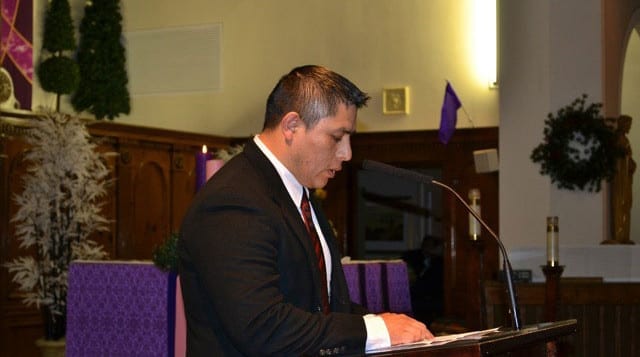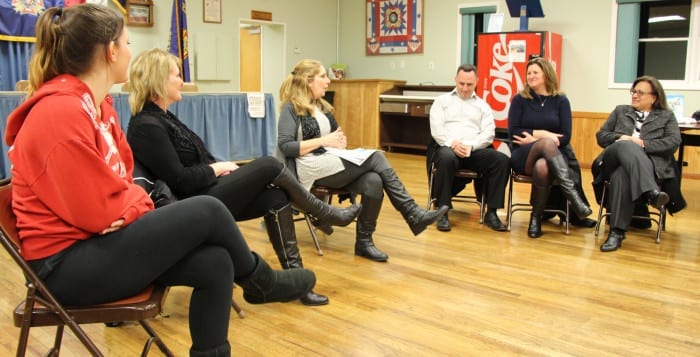By Michael Tessler
Theatre Three’s production of “Godspell,” which opened last Saturday night, is local theater at its finest. A musical by Stephen Schwartz and John-Michael Tebelak, it originally opened off Broadway in 1971 and has had many revivals since then. Uniquely reimagined by director Jeffrey Sanzel, Theatre Three’s production succeeds in every category with beautiful lighting, a fluid set, expert choreography, tremendous acting and voices that will leave you yearning for more.
Sanzel, who had previously directed several productions of “Godspell,” brings a refreshing twist to the story, having it take place in the here and now. The cast portray not characters, but their actual selves. Everything you watch is playing out in real time, and it genuinely feels like it’s happening for the first time. The result is miraculous, as it adds a depth and weight to the show that makes it all the more human.
Biblical Spoiler Alerts: Each touch, every moment of embrace, was so unique and powerful. You feel so connected with the magnanimous presence of Jesus, portrayed masterfully by Hans Paul Hendrickson. You sympathize with Judas (Patrick O’Brien) whose dynamic personality and lovability makes his betrayal all the more devastating and personal.
Broken into two acts, the first is a series of parables told by Jesus’ disciples through songs and skits. They will have you in stitches from laughing. Each parable contains a beautiful lesson of morality. In the second act you bear witness to the betrayal of Jesus. Though the tone of the show dramatically changes, the cast still delivers, showing off their impressive range as actors.
What’s most remarkable about this production is its cast. This ensemble effortlessly plays with your heartstrings as their harmonies echo through the belly of the theater. They don’t limit their stage to the stage. More often than not they’re in the audience sharing the experience with you. Their collective voice is so powerful, so beautiful, and instills you with a sense of togetherness. During the production you feel as though you’re a part of something very special.

In Act One, Amanda Geraci serenades with perfection in her rendition of the musical theater classic “Day by Day.” Bobby Montaniz’s booming voice rings perfectly during his soulful performance of “All Good Gifts.” Act Two, though darker in tone, does have some upbeat moments. Among them is the devilishly sexy “Turn Back, O Man” performed by the talented Elena Faverio. You’ll hold back tears during “By My Side,” a beautiful duet between Jenna Kavaler and Aria Saltini. In the audience, you can’t help but feel the urge to clap and sing along.
The show’s excellent choreography is also to be noted. With each musical number it feels the cast members outdo themselves. No doubt this can be attributed to choreographer Marquez Stewart whose vision translated wonderfully on stage. Her direction of Jesus and Judas during “All for the Best” is a real treat as the duo tap dances in tandem. Many of the musical numbers cleverly include American Sign Language, adding an extra dimension to an already beautiful repertoire of music. “Godspell’s” other great success is in its attention to ambiance. Lighting designer Robert W. Henderson Jr. programs some of the most impressive light sequences I’ve ever seen in a local show. “Heavenly” seems like a fitting adjective.
Behind the cast is Steve McCoy, musical director, who leads a team of expert musicians who brought the score to life in a way that only great instrumentalists can. Randall Parsons’ costume design was also a job well done with Jesus wearing his signature Superman shirt and Judas adorned in what I assume was a cleverly repurposed military coat from “Les Miserables.” Every cast member’s costume so perfectly fit the quirkiness of their personalities. Also deserving of credit is stage manager Peter Casdia who expertly ran the production from behind the scenes.
Arguably the highlight of the show is one particular scene that turns the stage into an old-fashioned slide projector. Comically narrated by Judas, the entire audience erupted into five minutes of non-stop bellyaching laughter. If for this scene alone, go see this show.
“Godspell,” while inspired by the Gospel of Matthew and the Gospel of Luke, isn’t exclusively a Christian show. Its message of community, love and compassion are delivered in a way that doesn’t require you to adhere to the Christian doctrine. Even as a secular Jew, I found myself humming along to “We Beseech Thee” and thinking to myself “I love Jesus!”
Theatre Three, 412 Main St., Port Jefferson will present “Godspell” through March 26. Contains adult themes. Tickets range from $15 to $30. For more information, call 631-928-9100 or visit www.theatrethree.com.















